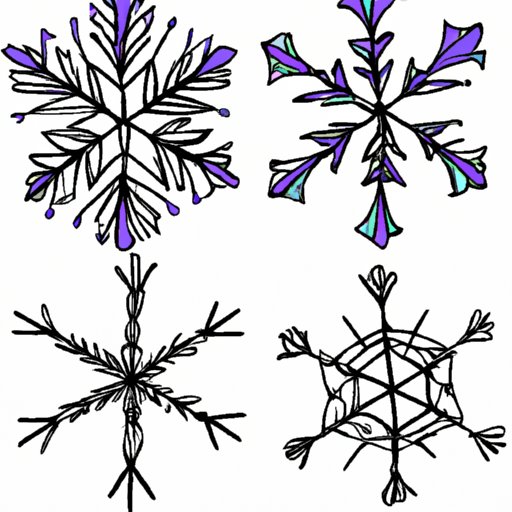Introduction
Have you ever looked at a snowflake up close and been mesmerized by its unique shape and intricate pattern? Drawing snowflakes can be a fun and creative way to capture their beauty and complexity on paper. However, for many people, drawing snowflakes can be intimidating. This article aims to provide a comprehensive guide on how to draw snowflakes, complete with helpful tips, tricks, and inspiration.
Step-by-Step Tutorial
To begin drawing a snowflake, start by drawing a small circle in the center of your paper. From there, draw six lines extending outward from the circle, evenly spaced apart. These lines will be the framework for your snowflake.
Next, draw smaller lines branching out from each of the six lines, mirroring each other symmetrically. These smaller lines should be slightly curved, creating a more organic and natural look to the snowflake. Keep in mind that the beauty of a snowflake comes from its unique shape and pattern, so don’t be afraid to experiment and try different variations.
Once you have drawn the smaller lines, you can begin to add in the details of the snowflake. This can include smaller branches, loops, or curves, depending on the style you want to achieve. It’s important to keep symmetry in mind as you add these details, as this is what makes a snowflake visually appealing.
To add depth and dimension to your snowflake, you can shade in certain areas with a pencil or add white ink or paint on top of your drawn lines. This can also help to make your snowflake stand out on the paper.
If you want to take your snowflake drawing to the next level, you can experiment with adding color or different mediums. Watercolors, colored pencils, and markers can all be used to add a pop of color to your snowflake, or to create a more abstract interpretation of a snowflake.
Tips and Tricks
To improve your snowflake drawing technique, there are a few tips and tricks that can make a big difference:
- Use a ruler or protractor to ensure that your lines are symmetrical and even.
- Start small – just like with any skill, it takes practice to get better at drawing snowflakes. Start with simple designs and work your way up to more complex ones.
- Play with the spacing and size of the branches to create different looks and styles.
- Try out different mediums and materials to see which one you like working with best.
- Remember that no two snowflakes are alike, so there’s no wrong way to draw a snowflake.
History and Facts
The unique shape and pattern of snowflakes has been the subject of scientific study for centuries. It wasn’t until the 1900s, however, that Wilson Bentley, also known as the “Snowflake Man,” became known for his photomicrographs of snowflakes. These images helped to reveal their true beauty and complexity, inspiring artists and scientists alike.
In addition to their scientific significance, snowflakes have also been used as a symbol of winter and the holiday season in many cultures. They have been incorporated into art, literature, and even music, making them a beloved and recognizable image around the world.
Inspiration and Ideas
There are a multitude of different styles and techniques when it comes to drawing snowflakes. Some people prefer a realistic approach, while others enjoy creating abstract or stylized designs. Here are a few ideas to help inspire your snowflake drawing:
- Take a walk outside and observe the different shapes and patterns of snowflakes you see. Use these as inspiration for your next drawing.
- Look up snowflake art or photography online and see how other artists have interpreted this iconic winter image.
- Try using different materials, such as glitter or metallic ink, to add texture and dimension to your snowflakes.
- Experiment with coloring your snowflakes, either with a monochromatic or multicolor approach.
Easy Snowflakes for Beginners
If you’re just starting out with snowflake drawing, there are a few simple designs that are perfect for beginners. One easy technique is to simply draw a series of triangles or diamonds that radiate outward from a center point. Once you have the basic shape down, you can add smaller details and branches to make it more unique.
Digital Art
Digital art can provide a new dimension to snowflake drawing, thanks to the endless array of software and apps available for artists. Tablets and drawing pads can allow you to create intricate designs using a stylus or mouse, which can be used for web design, printing, or animation. Some popular software for digital snowflake drawing includes Adobe Illustrator, Procreate, and Sketchbook Pro.
Conclusion
Drawing snowflakes may seem daunting at first, but with a little practice and experimentation, anyone can create beautiful and unique snowflakes. Whether you prefer a traditional or modern style, there’s no wrong way to draw a snowflake.
